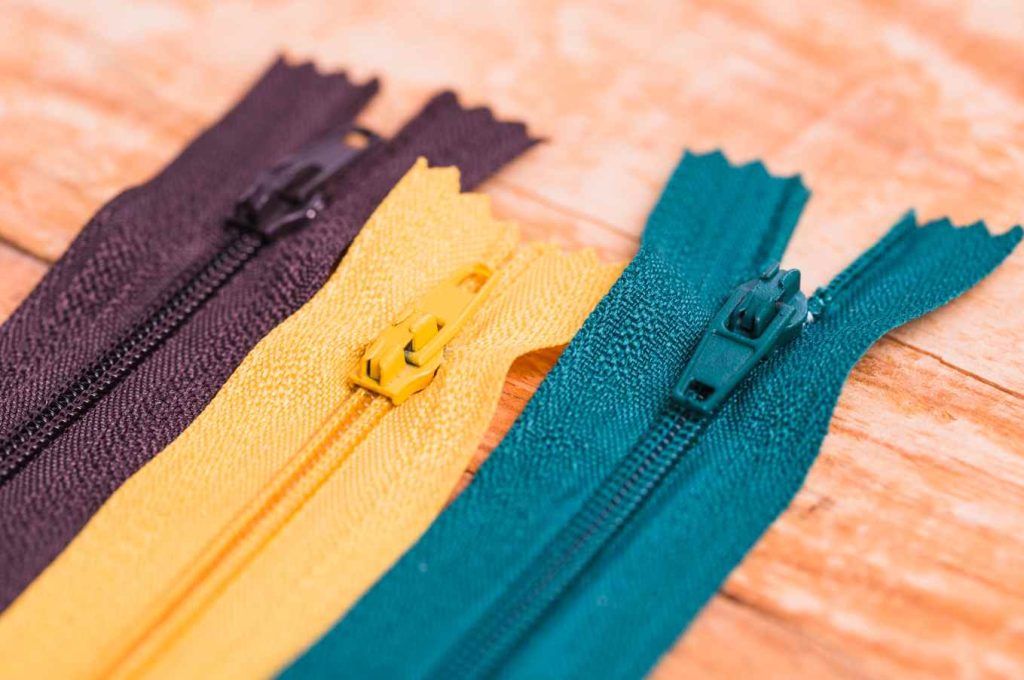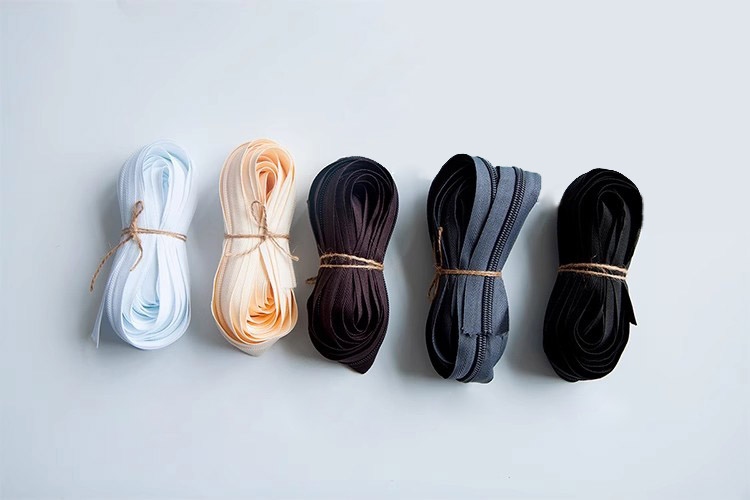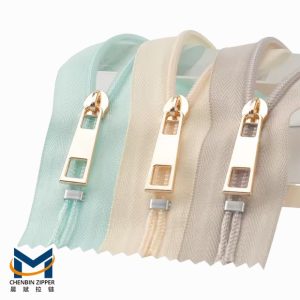O que faz os Zippers Invisibles diferentes dos Regulares?
O que é um Zipper Invisible?
Um cerro invisível é um tipo de cerro de bobina onde os dentes estão escondidos debaixo da fita de tecido, então apenas é perceptível quando cerrado. A página é pequena e a fita é feita de nílon ligeiro, deixando-a misturar diretamente em seu tecido ou roupa. Isso dá um olhar limpo e polido, ótimo para coisas como vestidos, saias ou vestidos fantásticos onde você quer que o fecho fica sutil.
Como os Zippers Regulares Funcionam na Sewing?
Os zippers regulares, às vezes chamados zippers padrões ou centrados, são mais óbvios em roupas. Eles têm dentes visíveis que se encerram para fechar a roupa e você os coja no meio de uma cor com um pé padrão. Você verá isto em roupas casuais ou designs onde o zipper faz parte do olhar.
Como eles são diferentes em olhar e construir?
Como eles olham em Seams
Ao contrário dos zippers normais, os zippers invisíveis escondem-se dentro do tecido, com apenas a página de pulsão mostrando. Isso os faz maravilhosos para roupas bonitas ou de classe onde você não quer nada quebrar a vibração bonita. Contudo, os zippers regulares estão abertos e podem brincar com um fluxo de roupa se você não planeja para eles.
Zipper Tape and teeth Setup
Com zippers invisíveis, os dentes estão na parte de trás ou dentro da fita, então eles ficam fora de vista na peça acabada. Os zippers regulares têm dentes na frente que vocês podem ver depois de costurar. Os zippers invisíveis geralmente têm bobinas de nylon mais finas, que são suaves e dobradas.
Como secar um Zipper Invisible em roupas?
O que você precisa para secar um Zipper Invisible
Para instalar um zipper invisível da maneira certa, pegue isto:
- Um zipper invisível
- Fio que coincide com seu tecido
- Um pé invisível de zipper
- Pins ou Wonder Tape
- Um ferro (definido para calor baixo ou médio)
Escolhar o melhor pé de pressão
Vai buscar um pé invisível de cerveja com arbustos para costurar dentes. Isso permite que sua agulha se aproxima muito da bobina sem bater nela, então apenas o tabuleiro de pulsão mostra quando você acaba.
Preparar o Seam e o Zipper
Fabric: Limpa bordos crus com um ponto de zigzag ou sargento. - Mantenham as peças de tecido separadas.
Zipper: Irene ligeiramente o zipper invisível com uma configuração fria ou média para arranjar os dentes. Isso facilita a coseira.
Instruções de Zipper Invisible Step-by-Step
Alinhando o Zipper
Coloque o rosto do zipper no lado direito do seu tecido, correspondendo a sua borda com a cobertura de cor. Pin ou baste para mantê-lo em posição.
Pegando para um olhar escondido
Deslizar os dentes do zipper nas cavernas do pé invisível do zipper. Começa a costurar no topo, ficando perto da bobina. Faça o mesmo para o outro lado. Quando ambos os lados forem feitos, mudar para um pé de pressão regular para costurar a cor embaixo, começando justo debaixo de onde termina o zipper.
Erros para vigiar quando secar Zippers Invisibles
- Esquecendo de ferrar as bobinas planas antes de começar
- Usando um pé de pressão normal em vez de um pé invisível
- Sejar muito longe ou direito para a bobina
- Ficar os lados do tecido desiguais
- Saltar a costura de trás para segurar os extremos
CB Zipper: Seu "Go-To" para "Top-Notch Invisible Zippers"
Quem é CB Zipper?
Somos CB Zipper, oficialmente HANGZHOU CHENBIN ZIPPER CO., LTD. e fazemos e vendemos todos os tipos de zippers incríveis, incluindo nossos zippers contínuos invisíveis de bobina de nílon.
Por que a CB Zipper Zíper invisívels Rock
Grandes materiais e fortaleza
Nossos zippers são feitos de nílon de alta qualidade, então eles duram muito e funcionam suavemente. Nós os colocamos através de testes difíceis, verificando 11 coisas como força de cadeia e como elas aguentam com uso repetido.
Sua e Dormida
Limpem seus projetos de costuração ou desgaste com nossos #3 zíperes contínuos de bobina de nylon invisíveisOrdem agora para ver como se misturam perfeitamente e se mantêm fortes.
Onde usar Zippers Invisibles na Sewing?
Nossos zippers contínuos invisíveis de bobina de nylon #3 são perfeitos para:
- Os vestidos de mulheres
- vestidos de casamento
- Costumes fantásticos
- Cushions e almofadas
- Bolsas que precisam de um fecho de baixa chave
Como consertar um Zipper Invisible que está agindo?
Por que os Zippers Invisibles ficam presos ou partidos?
Eles podem congelar por causa de dentes mal alinhados, terra nas bobinas ou um slider barato. Coturar mal pode também causar batimentos que impedem que se mexa suavemente.
Como consertar um Zipper Invisível Quebrado ou Wonky?
Direcionar os Detos
Desbloquea tudo o caminho. Usem pinceiros ou dedos para empurrar quaisquer rodas crocadas de volta para o lugar. Teste o slider antes de costurar novamente, se necessário.
Trocar um slider ruim ou tirar a página
Se o brinde do slider:
- Apanhei a parada superior para remover o velho slider.
- Deslizar gentilmente numa nova.
- Sejam uma nova parada acima dela com ciclos de fios sólidos.
Conselhos para manter seu Zipper funcionando
Verifique seu ponto enquanto você vai para ter certeza de que é mesmo. Fiquem com zippers de alta qualidade como CB Zipperque s ão testados para ser confiáveis. Não tire muito duro quando abre ou fecha suas roupas.
Quando você deveria escolher um Zipper Invisible sobre um Regular?
Que roupas funcionam melhor com Zippers Invisibles?
Os zippers invisíveis têm um olhar suave e limpo, então são ótimos para projetos simples ou elegantes. Pense:
- vestidos de casamento
- Vestes de noite
- vestidos encaixados
- Skirts que precisam de linhas não quebradas
Como Fabric muda sua escolha de Zipper?
Tecidos ligeiros como chiffon ou seda vão ótimos com tamanhos invisíveis de zipper #3, uma vez que não são grandes. Para tecidos mais grossos, você pode precisar de tamanhos #5 mais duros, dependendo do seu projeto. CB Zipper tem todo tipo de tamanhos invisíveis de zipper para corresponder a diferentes tecidos enquanto mantém as coisas clasificadas.
FAQ
Q: Como sei se tenho um zipper invisível ou regular?
A: Cala e olha. Os zippers invisíveis escondem os dentes atrás da fita, com apenas uma pequena linha de pulso mostrando. Os zippers regulares mostram os dentes ao longo do comprimento.
Q: Posso usar um zipper invisível em tecidos pesados?
A: Sim, mas escolha tamanhos maiores como #5 para for ça extra. O CB Zipper tem opções personalizadas, incluindo tamanhos extra longos invisíveis, que funcionam muito bem para coisas mais espessas.
Q: Por que meu zipper invisível continua a aparecer aberto?
A: Isso geralmente é de um alinhamento de pontos ruim ou um slider de baixa qualidade. Segue instruções de zipper invisíveis precisas e utiliza bons materiais quando você instala um zipper invisível.







